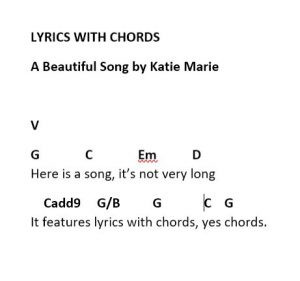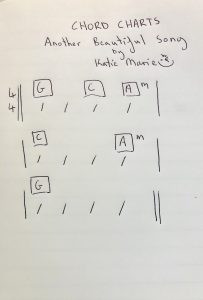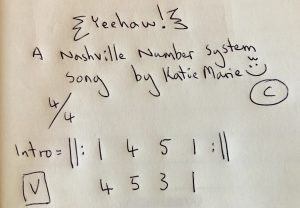Being prepared with clear and concise chord charts is essential for any musician, especially guitarists, whether you’re jamming with friends, performing live, or recording in the studio. For guitar players just starting out, navigating complex musical scores can be daunting. That’s where the beauty of Easy Guitar Chord Charts comes in. This guide will walk you through simple and effective ways to create and use chord charts, making music more accessible and enjoyable.
Understanding Chord Chart Basics
Before diving into different types of chord charts, let’s grasp the fundamental elements. A chord chart is essentially a simplified roadmap of a song, focusing on the chords and song structure. Think of it as a cheat sheet that keeps everyone on the same musical page. To keep things clear and concise, especially in easy guitar chord charts, we often use abbreviations for song sections:
- V: Verse – the storytelling part of the song.
- C or CH: Chorus – the memorable, often repeated section.
- B or BR: Bridge – a contrasting section that adds variety.
- Inst: Instrumental – sections without vocals, often featuring solos or instrumental breaks.
These abbreviations help create a skeletal structure for your chart, making it easy to follow the song’s progression at a glance.
Types of Easy Guitar Chord Charts for Beginners
When it comes to guitar chord charts, simplicity is key, especially when you’re learning. Here are a few easy-to-follow methods perfect for guitarists of all levels:
1. Lyrics with Chords: The Easiest Start
 Guitar chords over lyrics for a song verse, a simple chord chart example.
Guitar chords over lyrics for a song verse, a simple chord chart example.
For guitarists, especially beginners, lyrics with chords are often the most approachable type of chord chart. It’s exactly what it sounds like: the lyrics of the song with chord names placed directly above the words where the chord changes occur.
Pros:
- Extremely Simple: Requires no music theory knowledge beyond basic chord names.
- Easy to Follow: Intuitive for singers and guitarists focusing on strumming and singing simultaneously.
- Quick to Create: Minimal effort to write out.
Cons:
- Rhythmically Ambiguous: Doesn’t specify the duration of each chord or rhythmic patterns within a measure.
- Less Precise: Can be less effective for songs with complex rhythmic changes or intricate instrumental parts.
Best for: Beginners, singer-songwriters, learning basic song structures, and quick practice sessions.
2. Basic Chord Charts with Rhythm Markings: Stepping Up Clarity
 Basic guitar chord chart example showing song section labels and rhythm markings for chord durations.
Basic guitar chord chart example showing song section labels and rhythm markings for chord durations.
To add more rhythmic clarity to your easy guitar chord charts, you can incorporate basic chord charts with rhythm markings. This type builds upon the simplicity of just chord names by visually representing the duration of each chord within a measure.
How it works:
- Measures/Bars: The chart is divided into measures (or bars), representing segments of time in the music.
- Time Signature: Understanding the time signature (e.g., 4/4 time) is helpful. 4/4 means four beats per measure.
- Rhythm Markings: Simple markings (like dashes or lines) are used to indicate how many beats each chord should be played for.
Example (in 4/4 time):
| G C Am | D G |
| / / / / | / / / / |In this example, each measure has four beats. In the first measure, ‘G’ gets two beats, ‘C’ gets one beat, and ‘Am’ gets one beat. In the second measure, ‘D’ and ‘G’ each get two beats.
Pros:
- Improved Rhythm Clarity: Provides a basic understanding of chord durations.
- Still Relatively Simple: Easy to grasp for guitarists with some rhythmic awareness.
- More Precise than Lyrics with Chords: Offers better guidance for timing.
Cons:
- Not Detailed Notation: Doesn’t represent complex rhythms or strumming patterns.
- Requires Basic Rhythm Understanding: Some familiarity with musical timing is beneficial.
Best for: Guitarists progressing beyond basic chords, bands needing a slightly more structured chart, and songs with moderately rhythmic parts.
3. Simplified Nashville Number System: Flexibility for Guitarists
 Nashville Number System chart example using numbers to represent chords in a key, useful for guitarists learning transposition.
Nashville Number System chart example using numbers to represent chords in a key, useful for guitarists learning transposition.
The Nashville Number System might sound intimidating, but it’s a remarkably efficient and, in its simplified form, can be an easy guitar chord chart method, especially when you want to play songs in different keys. Instead of using chord names (like G, C, D), it uses numbers to represent chords within a key.
Basic Concept (Major Key):
- 1: Represents the major chord built on the root of the key.
- 2: Represents the minor chord built on the second degree of the scale.
- 3: Represents the minor chord built on the third degree of the scale.
- 4: Represents the major chord built on the fourth degree of the scale.
- 5: Represents the major chord built on the fifth degree of the scale.
- 6: Represents the minor chord built on the sixth degree of the scale.
- 7: Represents the diminished chord built on the seventh degree of the scale.
Example in the Key of C Major:
- 1 = C Major
- 2 = D minor (Dm)
- 3 = E minor (Em)
- 4 = F Major
- 5 = G Major
- 6 = A minor (Am)
- 7 = B diminished (Bdim)
Chord Chart Example (in C Major):
| 1 1 4 5 | 1 1 2 2 |This translates to:
| C C F G | C C Dm Dm |The Power for Guitarists: If you want to play the same chord progression in the key of G Major, the numbers stay the same! You just apply them to the G Major scale:
- 1 = G Major
- 2 = A minor (Am)
- 3 = B minor (Bm)
- 4 = C Major
- 5 = D Major
- 6 = E minor (Em)
- 7 = F# diminished (F#dim)
The same number chart in G Major becomes:
| G G C D | G G Am Am |Pros:
- Key Transposition: Effortlessly change keys without rewriting the chart – incredibly useful for guitarists playing with singers or experimenting with song keys.
- Simplicity in Structure: Once you understand the number system, charts are very clean and concise.
- Musical Understanding: Encourages a deeper understanding of chord relationships within keys.
Cons:
- Initial Learning Curve: Requires understanding the number system and key signatures.
- Less Intuitive Initially: Not as immediately readable as chord names for beginners.
Best for: Guitarists wanting to transpose songs, musicians playing in different keys frequently, and those interested in music theory basics.
Creating Your Own Easy Guitar Chord Charts
Creating your own easy guitar chord charts is a valuable skill. Here are a few tips:
- Start Simple: Begin with “Lyrics with Chords” for the quickest and easiest charts.
- Listen Carefully: Listen to the song and identify chord changes.
- Use Abbreviations: Employ standard section abbreviations (V, CH, B, Inst).
- Be Consistent: Choose a charting method and stick with it for consistency.
- Keep it Readable: Use clear handwriting or a legible font if typing.
- Practice Charting: The more you chart songs, the faster and easier it becomes.
Final Thoughts
Easy guitar chord charts are powerful tools for guitarists of all levels. They simplify music notation, making songs accessible for learning, practice, and performance. Whether you prefer lyrics with chords, basic chord charts, or venture into the Nashville Number System, the goal is clarity and ease of use. Experiment with these methods, find what works best for you, and enjoy making music!
